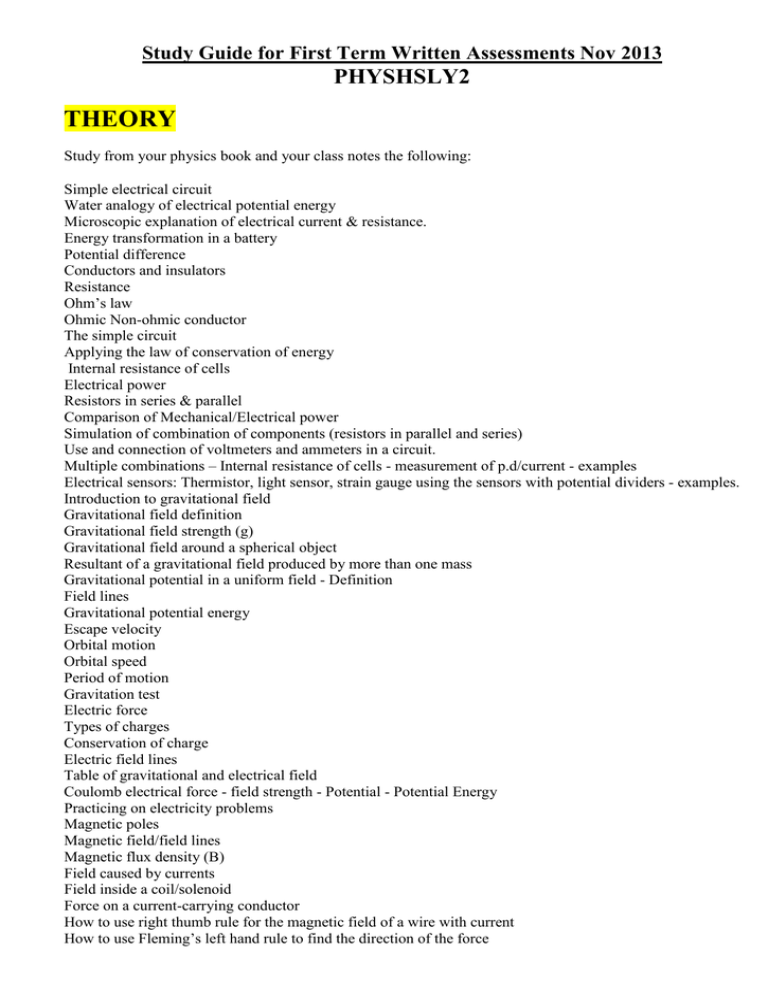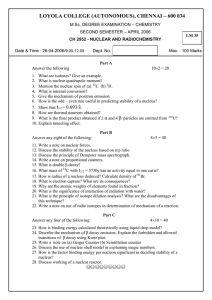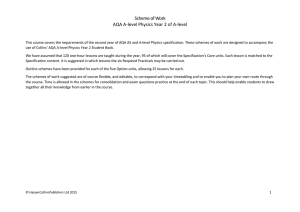theory - Isa.edu.gr
advertisement

Study Guide for First Term Written Assessments Nov 2013 PHYSHSLY2 THEORY Study from your physics book and your class notes the following: Simple electrical circuit Water analogy of electrical potential energy Microscopic explanation of electrical current & resistance. Energy transformation in a battery Potential difference Conductors and insulators Resistance Ohm’s law Ohmic Non-ohmic conductor The simple circuit Applying the law of conservation of energy Internal resistance of cells Electrical power Resistors in series & parallel Comparison of Mechanical/Electrical power Simulation of combination of components (resistors in parallel and series) Use and connection of voltmeters and ammeters in a circuit. Multiple combinations – Internal resistance of cells - measurement of p.d/current - examples Electrical sensors: Thermistor, light sensor, strain gauge using the sensors with potential dividers - examples. Introduction to gravitational field Gravitational field definition Gravitational field strength (g) Gravitational field around a spherical object Resultant of a gravitational field produced by more than one mass Gravitational potential in a uniform field - Definition Field lines Gravitational potential energy Escape velocity Orbital motion Orbital speed Period of motion Gravitation test Electric force Types of charges Conservation of charge Electric field lines Table of gravitational and electrical field Coulomb electrical force - field strength - Potential - Potential Energy Practicing on electricity problems Magnetic poles Magnetic field/field lines Magnetic flux density (B) Field caused by currents Field inside a coil/solenoid Force on a current-carrying conductor How to use right thumb rule for the magnetic field of a wire with current How to use Fleming’s left hand rule to find the direction of the force Electromagnetic induction Conductor moving in a magnetic field Induced emf Conservation of energy Fleming’s right hand rule Calculating induced emf Faraday’s law Flux and flux density Coil rotating in a uniform magnetic field Effect of increasing angular speed Alternating current Root mean square The transformer Atomic structure The arrangement of charge in the atom The Rutherford model The Bohr model The connection between atoms and light Atomic spectra The hydrogen spectrum Transmission of electrical power The quantum nature of light The photoelectric effect The swimming pool analogy The zinc plate experiment Quantum model of light Millikan’s photoelectric experiment Einstein’s photoelectric equation Quantum explanation of atomic spectra Ionization Absorption of light The electron gun Detecting electrons Electron diffraction The de Broglie hypothesis Probability waves Explaining diffraction Heisenberg’s uncertainty principle Quantum models of the atom The electron in a box Schrödinger’s model Nuclear structure Mass of the nucleus Charge of the nucleus Size of the nucleus Quantities and terms related to the nucleus The nuclear force (strong force) Binding energy The binding energy curve Worked example of the binding energy of iron (Fe) Radioactive decay Alpha radiation (α) Effect on nucleus Energy released Alpha energy Beta minus (β -) Effect on nucleus Beta energy Beta-plus (β +) decay Effect on nucleus Gamma radiation (γ) Gamma energy Decay chains Nuclear radiation and health Half-life The exponential decay curve Half-life Activity Carbon dating Nuclear reactions Transmutation Transmutation of nitrogen into carbon Nuclear fusion Nuclear fission The above material was covered from 9/13 to 11/13. You will study also Year 1 physics. If you want to know if you are ready in theory then make sure that you will cover from the physics syllabus document the highlighted items.




